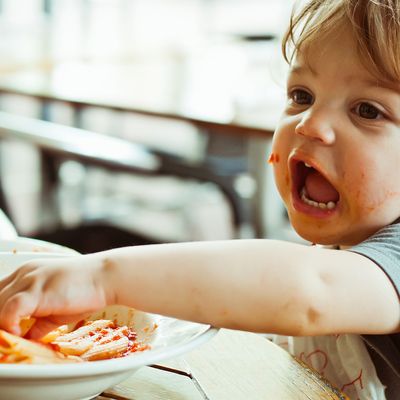
When it comes to providing sustenance for tiny children, I think the most frustrating advice is “just feed them some of what you’re eating.” However well intentioned, this directive grossly misleads by suggesting simplicity where none is found. None.
At the very least, kiddifying an adult meal means first physically altering it in some way. You have to tear big bits into tiny, bite-size bits, or you have to grind large hunks up via machine — you have to find the blender, assemble it, then get around to cleaning it, eventually. Second, do you like spicy foods made mostly from shapes that are easy to choke on? Me too. Third, there’s the problem of the meal itself. Where is it?
Feeding a teeny-tiny, plus yourself, is anything but simple. This is why an essay by my former Cut colleague Maggie Lange caught my tired eyes: “Weird Toast Will Save You When You Don’t Know What to Eat,” in which Lange describes a method of creative dining when the time’s not right for a full meal. Finally, I thought, something that contributes to my theory of eating while raising a small child: Instead of feeding your child an adapted version of what you’re eating, feed yourself an adapted version of what your child is eating. This cuts down on time and has the potential to be fun.
While Lange doesn’t directly address feeding from a parent’s point of view, her methodology is ripe for our purposes: “Weird toast” is somewhere between a snack and dinner, constructed and consumed at odd times. The foundation is familiar — bread — while the ingredient combinations might not be. (“Layer up some arugula,” Lange writes, “sardines, Balsamic vinegar.”) Crucially: “Are we cooking? No. Are we arranging? Yes.”
Arranging, as you might already know, is the most important skill in feeding both children and parents. It requires the foresight of a shopping trip and semi-stocked pantry, but not a weekend nap time spent frantically meal-prepping. Open the cupboard: You have peanut butter, crackers, veggie “crisps.” Check the fridge: watermelon chunks, half a banana, soggy roasted broccoli. Pick three items, four at most so no one gets overwhelmed, and there you go — a meal, deposited into the segmented BPA-free silicone plate you ordered off Amazon in the middle of the night. Just as Lange urged readers to build weird toast without hang-ups, I advise you not to worry about what goes together. Your child has no preconceived notions about the relationship between broccoli and peanut butter.
Now, time for the toddler to eat. I won’t tell you to relax or try to make it “fun.” Nor will I remind you not to ruin your own meal by taking too many inspirational bites. Eventually, the meal ends and it’s time to wipe hands and face. If your child has eaten every last bit of the items you chose, you can stop reading right now and go to hell. If she didn’t, worry not: Simply place the leftovers next to the sink or in the fridge and commence bedtime.
Once bedtime’s over, time to get back to the meal. Your meal started a bit earlier; that’s a little weird, but go with it. The good news is you assembled some food for your toddler and, using the weird-food philosophy, you’re partway there. You just need to dig the leftovers from each segment of your toddler’s plate and put them on a base. You might copy Lange and use toast. You could also use a box of greens, some premade grain, or pasta. Just glom what your toddler didn’t want onto the base and, if you’re really offended, keep something that doesn’t “go” on the side. Smear some potato bread with yogurt, a sprinkling of corn kernels. Your side is watermelon stamped with baby fingerprints.
Formerly, I’ve eaten with my toddler in secret, frantic ways, and not without a sense of shame. The way out, I think, is accepting there’s no way out. You just need to stay parked right by the food-splattered high chair and give into weird. Notice how your toddler eats without shame — she pops a cheese chunk into her mouth then flattens her palm over her lips to make sure that chunk doesn’t fall out. Parents can learn from this brand of determination.
Remember this too: The less grossed out you are, the better this philosophy will serve you. I won’t say much more; just know the only person watching you recycle food won’t remember anything you’ve done. So what if tiny hands grubbed that avocado in its previous life? In its life as an adult meal, it’s still nutrient dense and cost you at least $2.50.
The more you accept eating as a fluid, usually weird activity, where “meals” bleed into one another and start and stop on someone else’s whim, the more likely that “weird” will mean “fun,” and “gross” something like “surprisingly not bad.” Of course, don’t mistake weirdness for something that can make feeding a toddler all fun all the time. Did your baby refuse everything on his plate, then suck down half a pouch and a fistful of Cheerios before losing his mind? Don’t worry. Put him to bed, squirt the remainder of the pouch over yogurt, top with crushed Cheerios, and take a seat. Tomorrow’s going to be another weird day.





